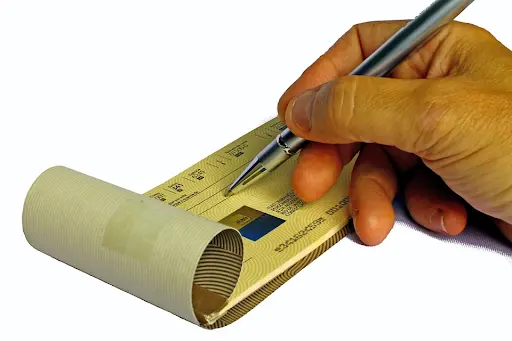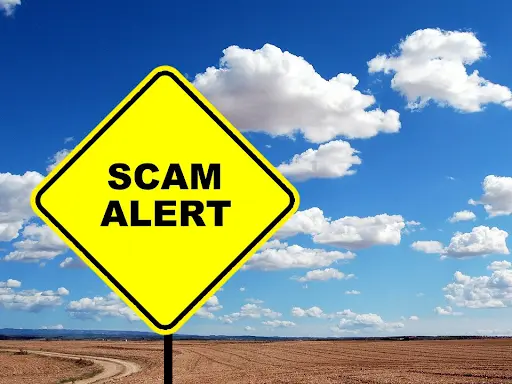What Is Check Fraud?
Find out what check fraud is, how to spot it, and what you can do to avoid it.
Our content follows strict guidelines for editorial accuracy and integrity. Learn about our and how we make money.
Check fraud is an umbrella term for several different types of scams that involve checks. While the use of checks has declined over the years, they are still a popular form of payment in the U.S., and the Federal Reserve found that there were 14.5 billion checks written in 2018. If you use checks, it’s important to understand how check scams work and how you can avoid them.
Read our guide to find out all about check fraud, what types of scams there are out there, and how you can protect yourself from falling victim to it.
What Is A Check?
A check is a financial instrument used by financial institutions that directs a bank or lender to pay a person on behalf of the authorized owner.
The owner or person writing the check is either known as a drawer or payor.
The person to whom the check is made out is known as the payee.
Even though checks are dated and signed documents, they usually have a number of additional security features to prevent copying, falsification, or tampering.
In today’s market, you can either get:
Physical checks: These are paper-based checks that you fill in, sign, and hand over to the recipient or payee.
Digital checks or eChecks: These are digital versions of physical checks which directly debit money from your account. They work similarly to physical checks but are considered more secure.
Some common security measures on checks include:
- Warning borders.
- Ghost or artificial watermarking.
- True watermarks.
- Micro printing.
- Thermochromic ink.
- Bleed-through numbering.
- Prismatic printing.
- Fluorescent fibers.
- Chemical reactive features.
However, despite their security features, checks have been and still are the focus of criminals and scam artists who use them to conduct fraudulent activities.

Source: Pixabay
What Is Check Fraud?
Check fraud refers to the willful manipulation, use, or alteration of a physical or digital check. This is usually done to obtain money fraudulently.
In the past, check fraud was mostly committed by using physical checks and changing the details on them or committing identity theft. It also involved printing or making fake checks and then using them to obtain money illegally from financial institutions.
There are two types of check fraud commonly committed. People can either perform check fraud with their own checks or accounts, or they can attempt to commit fraud with other people’s money.
The Different Types of Check Fraud
There are many different types of fraudulent schemes that people can use with checks.
Fraud that people commit with their own accounts:
Paperhanging: This is when a person writes a bad check from a closed account. For example, let’s say someone buys a TV for $500 with a check but the account isn’t open anymore and the check bounces.
Check kiting: This is when an account holder writes a bad check for themselves and then tries to deposit it at another bank. For example, if someone writes a check for $1,000 but only has $50 in their account and then they try and cash it at another bank.
Check floating: This is similar to paperhanging and is when a person writes a check but there are insufficient funds in the account to cover it. For example, if you deliberately bought an appliance worth $350 with a check and you only had $200 in your account.
Fraud that people commit with other people’s accounts:
Check forgery: This is when someone alters a check owner’s signature to take their money from them.
Check theft: This is when someone steals a checkbook or single check from someone else and tries to use it to withdraw money.
Identity theft: This is when a person uses the credentials of another person to open a bank account and tries to write checks with it.
Chemical alteration: This is another form of identity theft that involves the use of chemicals and other agents to change the appearance of checks, including the name, the account holder’s signature, the date, and the amount of money.
Counterfeiting checks: This involves illegally printing checks or making duplicates, copies, or altered versions of checks that are then used to withdraw money from a person’s bank account.
Synthetic checks: This is when a criminal uses a known routing number and account details but changes the payor information.
Money order fraud: This involves a person attempting to exchange money through a money transfer service or using money orders in return for a fake check of similar value, or more.

Source: Pexels
Common Check Fraud Schemes
Check fraud scams are highly organized operations that scam people out of millions of dollars.
There are a few common fake check scams you should keep an eye out for. If someone ever approaches you and you feel suspicious, always contact your bank or the local police to find out if their intentions are honest. Lottery or inheritance schemes: With this scheme, a scammer will contact a person and tell them they have won a lottery, prize, or received an inheritance. They’ll then post a fake cashier’s check for a large amount of money and ask you to cover the taxes or pay fees. When the person tries to cash the check, they find out that it is fake and realize that they’ve paid over money for nothing. For example, let’s say you receive an email from a person saying you have a long-lost family member who left you money. They want to send you the money, but there is an administration fee that you need to pay for the money to clear.
Overpayment scams: This is when a person posts something online and someone responds to the advert as an interested buyer. They’ll say that they can pay for the item and sometimes even say they’ll pay more for it than the listing price. They’ll then send you a check for an amount that is more than the asking price. For example, let’s say you list a piece of furniture for $300. The scammer might then send you a fake check for $500. They’ll then ask you to pay the difference back to them as they’ve overpaid you. Once you send them the money, they’ll disappear.
Mystery shopping schemes: This is a common scam that most people have heard about. How it works is that a scammer will contact you and say they are part of a company that manages mystery shopping or gift cards.
They’ll send you a fake check and then contact you saying that they made a mistake and that you’ll need to refund some of the money they’ve given you. Once you do this, they will disappear and the check will bounce.
Unsolicited check schemes: This scam involves sending people a check in the mail, which they then try to cash. Once they cash the check, they will usually be signed up for a membership or loan that withdraws money from their account each month. There are also other types of scams, including: Car decal scams: When people are conned into sending money as a deposit for vehicle wrapping at decal companies that don’t exist. Personal assistant scams: This is when people apply for a job as a personal assistant and are then sent a checkbook through the post office to pay for expenses to get started.
Once the purchases are made, the account holders' PIN numbers are stolen and the scammer attempts to steal their money. The checks then bounce once they’re processed by the bank.
Check fraud is more common than you might think. Here’s a look at how many checks were stolen in each state in October 2021.
Source: The Conversation, CC-BY-ND Source Evidence Based Cybersecurity Reseach Group

What to Do If You Fall Victim to Check Fraud?
If you have fallen victim to check fraud, you should contact your bank as soon as possible and tell them all of the details about the person who reached out to you. You should also contact the FTC to report the crime. In some cases, you may be able to get the money back or reverse the transaction; however, this isn’t generally the case.
Scammers are very adept at making sure that they can get away with their crimes, so the best way to protect yourself is to avoid getting conned by these tricksters.
If you are contacted by anyone claiming to represent a business, ask them for their contact details and google the actual business online. Contact their listed number and check that they are who they say they are.
Social engineering is a large part of most scams and fraud schemes. If a sales representative or person tries to play on your emotions, don’t let it affect your actions.
Some scammers claim to be law enforcement or IRS agents. If someone says this to you over the phone, ask them for their details. Tell them you’d like to seek legal advice before proceeding, and then contact the relevant agency (find their number through their .gov web address) to verify whether they are legitimate.
Never write checks to people if they act suspicious or if they are asking you to refund money through wire transfers such as Western Union. This is usually a scam and you should independently verify their claims before proceeding.
If people claim that money has been transferred to your account, wait at least a day and then visit your bank to check that this is the case before making any payments in return to them.
Be cautious when dealing with “support staff” from other countries. While large businesses do use foreign call center agents, this can be easily verified by googling their business name and sending the legitimate company an email with the caller's details.
Keep your physical checkbook safe at all times and make sure you report any theft as soon as it happens so that your bank can cancel the checks.
Never give your checkbook to anyone else, even close friends and family. Your checkbook should remain in your possession and care at all times.
FAQs about Check Fraud
What are the types of check fraud?
There are lots of different types of check fraud, including paperhanging, check kiting, check floating, identity check theft, check forgery, check theft, chemical alterations, counterfeiting, synthetic checks, and money order fraud.
How can you avoid check fraud?
To avoid check fraud, be vigilant about when you use your checkbook in public and to whom you write checks. Additionally, try to use other forms of online payment such as debit card and credit card purchases, if you are doing online shopping regularly.
What is check theft?
Check theft is the stealing of a person's checkbook or individual checks and the attempted use of it to withdraw money from any financial institution.
What is the jail time for check fraud? Sentences for check fraud will vary from state to state; however, under federal law, check fraud may be punishable with a sentence of up to 30 years along with heavy fines. Attempted check fraud can carry sentences of less than a year to more than five years.

Source: Pexels
Our Verdict on Checks and Check Fraud
If you’re a user of physical and digital checks, then you should be on guard against check fraud. Especially in this modern-day age, you can easily become a victim of check fraud even if you don't use checks on a regular basis.
There are three things you can do to not become a victim of check fraud. 1) Be ready and alert: Take care whenever you use a physical or digital check and make sure that the person you’re giving the check to is reputable and trustworthy. Use a digital identity protection program to ensure that you are protected on all websites that you visit and interact with. 2) React quickly: Notify your bank, lender, or other financial institution as soon as you become aware of a potential crime. They will be able to assist you with stopping any transactions or payments. 3) Do rely only on checks for payments: Use other payment methods that have more security features such as credit cards and EFT payments.
Where Can I Learn More about Digital Identity Protection?
At PolicyScout, we’ve made it our goal to simplify topics so that everyday consumers can make sense of their options. If you’d like to learn more about carding, credit card fraud, online scams, and ways to protect yourself against fraud, visit our digital identity protection hub today.
If you’re interested in improving your digital identity protection, speak to one of our agents to find the best products on the market and get help with choosing a provider. Call us today at 1-888-912-2132 or send us an email at help@policyscout.com to get started.